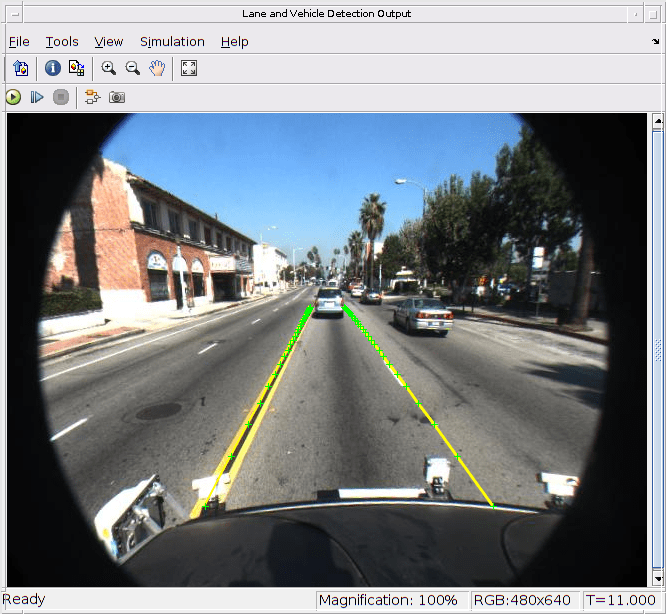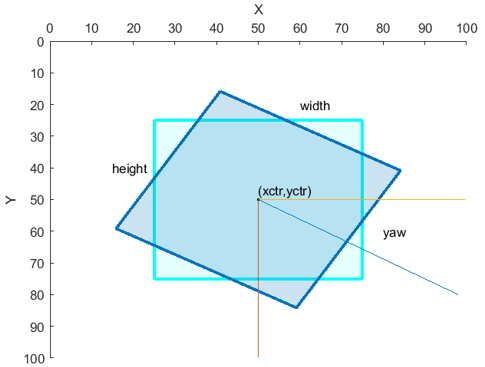Deep Learning Object Detector
Libraries:
Computer Vision Toolbox /
Analysis & Enhancement
Description
The Deep Learning Object Detector block predicts bounding boxes, class labels, and scores
for the input image by using the trained object detector specified through the block
parameter. This block allows loading of a pretrained object detector into the Simulink® model from a MAT file or from a MATLAB® function. This block provides a graphical interface for using the detector
objects in Simulink. To enable some parameters of the Deep Learning Object Detector block you must
choose an object detector that supports those parameters. For example, using a
yolov2ObjectDetector object with this block enables you to select
parameters similar to the name-value arguments of the associated detect object
function.
Ports
Input
Image — Image data
array
An H-by-W-by-C numeric array, where H, W, and C are the height, width, and number of channels of the image, respectively. Only one image per time step is allowed as input.
Output
Bboxes — Locations of objects detected
matrix
Locations of the objects detected within the input image, returned as an M-by-4 or an M-by-5 matrix. M is the number of bounding boxes detected in the image. You can put an upper bound to the size M by specifying the Maximum Number of Detections parameter.
The table describes the format of bounding boxes.
| Bounding Box | Description |
|---|---|
Axis-aligned rectangle |
Defined in spatial coordinates as an M-by-4 numeric matrix with rows of the form [x y w h], where:
|
Rotated rectangle |
Defined in spatial coordinates as an M-by-5 numeric matrix with rows of the form [xctr yctr w h yaw], where:
|
For more information, see Datastores for Deep Learning (Deep Learning Toolbox).
Labels — Labels for bounding boxes
vector
Labels for the bounding boxes, returned as an M-by-1 enumerated vector. M is the number of bounding boxes detected in the image.
Scores — Detection scores
vector
Detection confidence scores for each label, returned as an M-by-1 vector. M is the number of bounding boxes detected in the image. A higher score indicates higher confidence in the detection.
Parameters
Detector — Source for trained detector object
Detector from MAT file (default) | Detector from MATLAB function
Select the source for the detector object from these options:
Detector from MAT file— Import a detector object from a MAT file. For example, select a MAT file containing anrcnnObjectDetectorobject.Detector from MATLAB function— Import a detector object from a MATLAB function. For example, specify the functionvehicleDetectorYOLOv2, which returns a trainedyolov2ObjectDetectorobject.
The imported detector must be one of these supported objects:
rcnnObjectDetectorfastRCNNObjectDetectorfasterRCNNObjectDetectorssdObjectDetectoryolov2ObjectDetectoryolov3ObjectDetectoryolov4ObjectDetector
Programmatic Use
Block Parameter:
Detector |
| Type: character vector, string |
Values:
Detector from MAT file' | 'Detector from MATLAB
function' |
Default:
Detector from MAT file' |
File path — MAT file containing detector object
untitled.mat (default) | MAT file name
This parameter specifies the name of the MAT file that contains the detector object to load. If the file is not on the MATLAB path, use the Browse button to locate the file.
Dependencies
To enable this parameter, set the Detector parameter to
Detector from MAT file.
Programmatic Use
Block Parameter:
DetectorFilePath |
| Type: character vector, string |
| Values: MAT file path or name |
Default:
'untitled.mat'
|
MATLAB function — MATLAB function name
untitled (default) | MATLAB function name
This parameter specifies the name of the MATLAB function that returns a trained
object detector. For example, specify the function
vehicleDetectorYOLOv2, which returns a trained
yolov2ObjectDetector object, or specify a custom function.
Dependencies
To enable this parameter, set the Detector parameter to
Detector from MATLAB function.
Programmatic Use
Block Parameter:
DetectorFunction |
| Type: character vector, string |
| Values: MATLAB function name |
Default:
'untitled' |
Region of interest — Search region of interest
vector of the form [x
y
width
height]
Specify the search region of interest as vector of the form [x y width height]. The vector specifies the upper-left corner and size of a region in pixels.
Dependencies
To enable this parameter, select the Specify region of interest parameter.
Programmatic Use
Block Parameter:
ROI |
| Type: character vector, string |
Values: character vector specified as
'[x y width
height]' |
Default:
'[1 1 100 100]' |
Detection threshold — Detection threshold
scalar in the range [0, 1]
Specify the detection threshold as scalar in the range [0, 1]. Detections that have scores lower than this threshold value are removed. To reduce false positives, increase this value.
Dependencies
To enable this parameter, you must use a detector that supports the
Detection threshold parameter. For example, use a
yolov2ObjectDetector object.
Programmatic Use
Block Parameter:
Threshold |
| Type: character vector, string |
| Values: scalar |
Default:
'0.5' |
Number of Strongest Regions — Maximum number of strongest region proposals
2000 (default) | positive integer
Specify the maximum number of strongest region proposals as an integer. Reduce this
value to speed up processing at the cost of detection accuracy. To use all region
proposals, specify this parameter as Inf.
Dependencies
To enable this parameter, use a detector that supports the Number of
Strongest Regions parameter. For example, use an
rcnnObjectDetector object.
Programmatic Use
Block Parameter:
NumStrongestRegions |
| Type: character vector, string |
| Values: integer |
Default:
'2000' |
Maximum Region Size — Maximum region size
vector of the form [height
width]
Specify the maximum region size as a vector of the form [height
width]. Units are in pixels. The maximum region size defines the size
of the largest region containing the object. For example, [50
50] sets the size of the largest region containing the object to
50-by-50 pixels. To reduce computation time, set
this value to the known maximum region size for the objects that can be detected in the
input test images.
Dependencies
To enable this parameter
Select the Specify maximum region size parameter.
Use a detector that supports the Maximum Region Size parameter. For example, use a
yolov2ObjectDetectorobject.
Programmatic Use
Block Parameter:
MaxSize |
| Type: character vector, string |
Values: character vector specified as
'[height width]' |
Default:
'[50 50]' |
Minimum Region Size — Minimum region size
vector of the form [height
width]
Specify the minimum region size as a vector of the form [height
width]. Units are in pixels. The minimum region size defines the size
of the smallest region containing the object. For example, [1
1] sets the size of the smallest region containing the object to
1-by-1 pixels.
Dependencies
To enable this parameter
Select the Specify minimum region size parameter.
Use a detector that supports the Minimum Region Size parameter. For example, use a
yolov2ObjectDetectorobject.
Programmatic Use
Block Parameter:
MinSize |
| Type: character vector, string |
Values: character vector specified as
'[height width]' |
Default:
'[1 1]' |
Maximum Number of Detections — Maximum number of detections
500 (default) | positive integer
Specify the maximum number of detections as a positive integer. This value is the upper bound for the number of detections.
Programmatic Use
Block Parameter:
MaxDetections |
| Type: character vector, string |
| Values: integer |
Default:
'500' |
Extended Capabilities
C/C++ Code Generation
Generate C and C++ code using Simulink® Coder™.
Usage notes and limitations:
The Language parameter in the Configuration Parameters > Code Generation general category must be set to
C++.For a list of networks and layers supported for code generation, see Networks and Layers Supported for Code Generation (MATLAB Coder).
GPU Code Generation
Generate CUDA® code for NVIDIA® GPUs using GPU Coder™.
Usage notes and limitations:
The Language parameter in the Configuration Parameters > Code Generation general category must be set to
C++.For a list of networks and layers supported for CUDA® code generation, see Supported Networks, Layers, and Classes (GPU Coder).
Version History
Introduced in R2021b
See Also
Objects
rcnnObjectDetector|fastRCNNObjectDetector|fasterRCNNObjectDetector|ssdObjectDetector|yolov2ObjectDetector|yolov3ObjectDetector|yolov4ObjectDetector
Blocks
- Image Classifier (Deep Learning Toolbox) | Predict (Deep Learning Toolbox)
MATLAB Command
You clicked a link that corresponds to this MATLAB command:
Run the command by entering it in the MATLAB Command Window. Web browsers do not support MATLAB commands.

Select a Web Site
Choose a web site to get translated content where available and see local events and offers. Based on your location, we recommend that you select: .
You can also select a web site from the following list:
How to Get Best Site Performance
Select the China site (in Chinese or English) for best site performance. Other bat365 country sites are not optimized for visits from your location.
Americas
- América Latina (Español)
- Canada (English)
- United States (English)
Europe
- Belgium (English)
- Denmark (English)
- Deutschland (Deutsch)
- España (Español)
- Finland (English)
- France (Français)
- Ireland (English)
- Italia (Italiano)
- Luxembourg (English)
- Netherlands (English)
- Norway (English)
- Österreich (Deutsch)
- Portugal (English)
- Sweden (English)
- Switzerland
- United Kingdom (English)

